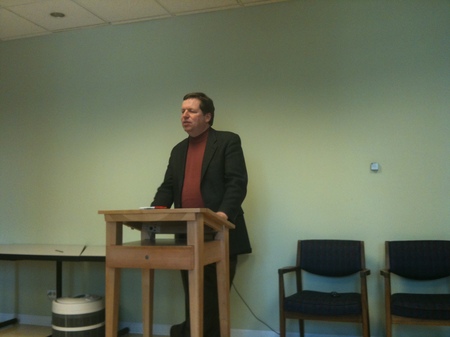| « Mayor-Elect Announces Transportation Team | He's Your Mayor To Be » |
Environment/Sustainability Thu Apr 21 2011
Rallying for the Clean Power Ordinance

Co-sponsor Ald. Joe Moore (49th) speaks at a Sierra Club meeting about the ordinance in April 2010
After a year of battles, lobbying and hopeful waiting, the Clean Power Ordinance, long-awaited legislation that would reduce pollution emitted from the Fisk and Crawford coal plants in Chicago, might see life outside of council committees.
Supporters of the ordinance will gather at 9:15 this morning outside Council Chambers (the 2nd floor of Chicago City Hall, 121 N. LaSalle St.), for a press conference about the ordinance, followed by a Health and Energy, Environment and Public Utilities committees hearing.
The proposed ordinance, introduced last year in City Council, sets standards for two of Chicago's worst polluters -- Fisk Generating Station and the Crawford Generating Station -- to limit harmful particle matter (soot) and Carbon Dioxide emissions. At a Sierra Club meeting on the topic last year, proponents argued that these limits are feasible for both the coal-burning plants, which were built in the 1950s and were often exempt from certain regulations because of their age.
The plants, owned by Midwest Generation, release thousands of pounds of dangerous skin, lung and organ toxicants, severely affecting the health of millions in the Chicago area, especially Little Village and Pilsen residents. The ordinance cites a 2001 Harvard School of Public Health study that states air pollution specifically from Fisk and Crawford causes more than 40 premature deaths, 550 emergency room visits and 2,800 asthma attacks every year.
After the committee hearing this morning, the ordinance could move forward for a vote by the full Council on May 4.
Follow the ordinance's progress and read more about the issue at the Clean Power Coalition's Website.
Supporters will also be streaming comments about the hearing at www.wheresmywalderman.com.












WAJ / April 22, 2011 11:33 AM
"The ordinance cites a 2001 Harvard School of Public Health study that states air pollution specifically from Fisk and Crawford causes more than 40 premature deaths, 550 emergency room visits and 2,800 asthma attacks every year"
AS I mentioned before, if these plants "caused" thousands of cases of asthma, then we would expect to see that Little Village would have the highest rates of asthma per capita in the Chicagoland area, since the power plants abutt that neighborhood.
However, it appears that proximity to one of these plants is a poor correlating factor.
Chicago Reporter April 28th 2008
- * Youth asthma hospitalization rates were higher in 15 suburban Cook County municipalities than in any ZIP code in Chicago. West suburban Stickney had the highest suburban rate at 1,820 hospitalized for every 100,000 youth
- * Of the 10 Chicago ZIP codes with the highest youth asthma hospitalization rates, nine are located in ZIP codes where blacks represent the largest racial group (obviously not Little Village or Pilsen).
- In 2004, the rates of four Chicago ZIP codes—60637 (Lawndale), 60649 (Jackson Park), 60644 (Oak Park and Maywood), and 60610 (Gold Coast and Cabrini) —and nearly 30 suburban Cook County municipalities were more than double the national rate of 274 hospitalizations for every 100,000 youth.
None of those neighborhoods are near those power plants.
Now let's take a look at the actual Harvard report.
http://www.lungchicago.org/site/files/487/37662/147127/270331/IL_paper_Atmos_Environ.pdf
"This study was commissioned by the Clean Air Task
Force."
- The study was commissioned by an organization with a vested interest in its findings, so the same skepticism should be applied as if the study was funded by a power company
"While some have tried to
reconcile the differences between these studies (Krupnick
and Burtraw, 1996; Levy et al., 1999), substantial
differences remained that were attributed in large part
to atmospheric modeling assumptions
"We developed an emission scenario meant to
reflect current emissions. Since the most recent publicly
available emissions at the time of our analysis did not
reflect recent emission controls at a subset of facilities,
we estimated current practice from a combination of
data sources. "
-hmmm. so they took it upon themselves to estimate reality?
For SO2 and NOx, we combined reported
emissions for the first two quarters of 2000 (EPA CEMS
database) with 1998 heat rates to estimate expected
annual emissions for 2000.
- Does the study take into account variations in heat rates? Everyone knows that gas dispersion is affected by differences in heat. The temperature in 1998 was close to an all time high if I'm not mistaken, where 2010 was below the historical mean.
climatestations.com/chicago/
1998's mean temp was 53.5 F, where 2000's actual mean temp was 49.8 F, so the study's estimate of 2000 was not even close to what 2000 was in actuality.
I could go on and on how many assumptions and estimates are used that introduce variabality and bias into that study, but lets see what other experts in the field had to say...
http://www.pilsenperro.org/coal/Harvard_comments_CALPUFF.pdf
"As explained below, several crucial but difficultto-
recognize problems with the Levy et al. (2002)
analysis compromise its reliability."
"The uncertainties associated with the modeling of
primary and secondary PM from power plant emissions
are substantial, yet they pale when compared to the
central uncertainties of the health-risk model used by
Levy et al. As the authors themselves note: ‘‘it
appears likely that the degree of uncertainty in atmospheric
modeling will not dominate the total uncertainty
associated with health impact or benefit estimation’’.
They also write that the concentration-response function
for excess mortality that they apply (Krewski et al.,
2000) is ‘‘quite uncertain and has numerous issues
associated with its implementation’’. These are understatements."
"Ambient PM is a mixture of thousands of
substances that vary in physical, chemical, and biological properties,
and no one knows which of these
substances, if any, hasten mortality."
"We do, however, have a good idea
as to what fractions of ambient PM are not likely to be
toxic, let alone fatal, and these fractions include
secondary sulfates and nitrates. As discussed elsewhere
(Green et al., 2002), the toxicologic, experimental
evidence on these compounds led the Netherlands
Aerosol Program (NAP, 2001), for example, to conclude
that ammonium sulfate and ammonium nitrate ‘‘seem[s]
to be toxicologically inert at current concentrations y
Decreasing the levels of inert compounds will not reduce
the health risk of the population’’.
"Given both (i) persistent uncertainties in
the air modeling and (ii) how little we understand about
what, if anything, in current, ambient, pollution-derived
PM in the United States accelerates death, we question
whether these multi-layered modeling exercises form a
reliable basis for public health policy making."
I sometimes wonder if environmentalists even understand the uncertainties of the science they purport to be unscrutable, or whether they just want to use it as a blunt instrument. The report cited, as well as other factual findings do not support any of the accusations that have put forth.